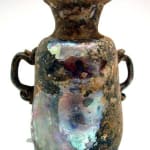Roman Glass Vessel, 1st Century CE - 3rd Century CE
Glass
3.375 x 4.25
X.0611
Further images
This glass vessel is forged with such technique and skill that modern hands would find it impossible to duplicate. For a fleeting instant of a generation or two, it graced...
This glass vessel is forged with such technique and skill that modern hands would find it impossible to duplicate. For a fleeting instant of a generation or two, it graced the table or mantelpiece of an opulent eastern aristocrat within the Roman empire, for surely in a world that valued glass over gold, none but the wealthiest and most tasteful would posses a piece of this quality. Then, by fire, by flood, or perhaps by deliberate placement to keep it from falling into the hands of thieves or bandits- this piece of fragile glass ended up in the earth for two thousand years. As it sat, the lustrous transparency through which one could see the amber of oil or violet of wine began to garner the colors of the earth around it. The vessel darkened into a more permanent and richer violet, and the interplay of glass with dust brought forth patches of glowing iridescence. Now, running our hands across the surface of this glass, we see in its bold shape and deliberate execution, a work of human genius that has withstood the rigors of two millennia, and done so in the most frail and delicate of mediums. It entices us with its beauty and the allure of its romantic existence, and reminds us that at one point in our history, the quality and beauty of a single piece of glass was important enough to merit such loving and laborious craftsmanship.









